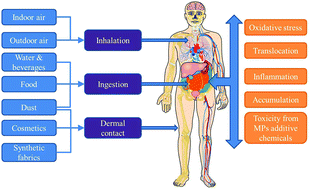Occurrence, human exposure, and risk of microplastics in the indoor environment
Abstract
Microplastics (MPs) are a group of emerging contaminants that have attracted increasing scientific and societal attention over the past decade due to their ubiquitous detection in all environmental compartments. So far, most studies on MPs focus on characterizing their occurrence, fate, and impact in the aquatic environment. Therefore, very little is known about the magnitude, patterns, and associated risks of human exposure to MPs, particularly indoors. This is a significant research gap given that people spend most of their time (up to 90%) indoors, which is exacerbated over the past year by COVID-19 lockdown measures. Critical evaluation of the existing literature revealed the presence of MPs at higher concentrations in indoor air and dust (from homes and offices) compared to outdoors. This was attributed to several factors including: indoor MPs sources (e.g. furniture, textiles), increased deposition of atmospheric MPs indoors, and less atmospheric mixing and dilution compared to outdoor air. Current understanding is that indoor human exposure to MPs occurs via a combination of inhalation, ingestion, and dermal contact. Dietary intake was considered the major pathway of human exposure to MPs until recent studies revealed potential high exposure via inhalation. Moreover, exposure via inadvertent dust ingestion and dermal contact cannot be neglected, particularly for young children. This is alarming due to the potential toxic implications of MPs exposure. Early toxicological evidence indicates that small MPs (<20 µm) can cause oxidative stress and inflammation, while particles <5 µm can be engulfed by cells and translocated to accumulate in different organs. Also, there is increasing concern over potential leaching of toxic chemicals used as plastic additives (e.g. plasticizers and flame retardants) upon exposure to MPs due to their large surface area. However, MPs exposure and risk assessment in humans is still in its infancy and more research is necessary to provide the knowledge base required for regulations to protect human health and environment against MPs.

- This article is part of the themed collections: Recent Open Access Articles, World Earth Day and Best Papers 2022 – Environmental Science: Processes & Impacts


 Please wait while we load your content...
Please wait while we load your content...